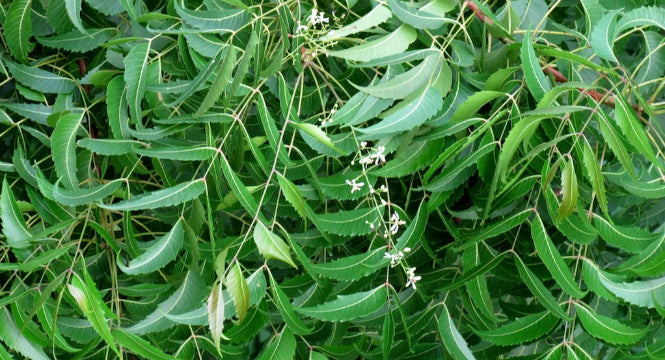Your Cart is Empty
FREE SHIPPING on US orders over $45. Save 25% With Code TAKE25 at checkout.
FREE SHIPPING on US orders over $45. Save 25% With Code TAKE25 at checkout.

Neem leaf extract benefits for skin are numerous, known for everything from healing to hydrating. Neem leaf, also known in Hindi as “neem ke patte,” comes from the neem plant, a fast-growing and long-living tree native to Burma, India.
The neem tree is known for its powerful healing properties and its medicinal uses go back as far as 4500 years. This tree has many names, including “tree of the 21st century,” “tree of life,” “divine Tree,”“life giving tree,” “nature’s drugstore,” and “village pharmacy.” Sanskrit documents show that it was called “nimba,” which means “good health.”
The entire neem tree is useful, and its leaves, seeds, and bark and can be used both externally and internally. The tree itself has a sort of pungent, sulfur-y smell, but it's not the plant's aroma that makes this an important staple in skincare.
Oil from the neem leaves contain nimbin, nimbinin, nimbolide, nimandial, ninnene - substances that give neem antiviral, antimicrobial, anti-fungal, anti-bacterial and anti-inflammatory properties. Gedunin and nimbidol specifically, are the components so powerful that they destroy fungi.
Neem also contains vitamin E, carotenoids, linoleic acid, oleic acid, vitamin C, and quercetin. One component, azadirachtin, is one of nature's most powerful insect repellents.
These natural ingredients make neem oil a potent anti-fungal, antipyretic, antibacterial, and anti-inflammatory. Neem oil is commonly used to combat bacterial skin infections and inflammations, such as eczema, dermatitis, and acne.
Neem has many external and internal medicinal properties. It is used to treat eye disorders and calm red, irritated skin and improve the health of the scalp and hair. Neem also reduces inflammation, promotes wound healing, and slows the aging process. All of these incredible benefits are why neem is commonly found in skin and personal care products, cosmetics, and soaps.
Ayurveda, one of the world’s oldest medical systems, is translated as “science of life.” Ayurvedic medicine, says the National Institutes for Health (NIH) is one of the world’s oldest medical systems, dating back more than 3,000 years. Originating in India, Ayurveda promotes the use of herbal compounds, special diets, and other unique health practices. It is sometimes included as part of Eastern medical practices, and India’s government and other institutes throughout the world support clinical and laboratory research on Ayurvedic medicine.
In this system, neem is traditionally used for cooling the body, boosting immunity, clearing the skin, and promoting healthy respiration and digestion. It's also used for healthy hair growth and skin hydration.
Researchers have found more than 300 compounds from the tree's flowers, bark, roots and seeds, making the entire tree, including the twigs, useful. Therefore, says Dermatology Times, it may be appropriate to take a closer look at its skin benefits.
Applying neem extract to your skin care routine will help delay the signs of aging and keep your skin glowing. Neem leaf extract is used for the skin to:
Neem has internal health benefits which ultimately reflect on the skin. It can also be taken internally via supplement, powder, or liquid. Some people use neem leaves to make a tea, some chew the leaves, while the bark is sometimes used as a food additive.
Neem is safe to ingest; however, it contains over 100 active ingredients, including some that yield a slight sedative effect, making it a powerful herb. Start slowly and carefully observe your tolerance levels, and note that it is not recommended to take neem internally if you are pregnant! Neem has been said to be used as an aid to gastric, oral, and reproductive health. There have even been some early research and unverified reports of it treating malaria and some cancers.
While research continues to investigate the full powers of neem for internal use, you don't have to wait to use neem topically to make your skin clean, clear, and healthy.